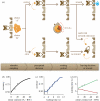A computational framework for the study of confidence in humans and animals
- PMID: 22492750
- PMCID: PMC3318772
- DOI: 10.1098/rstb.2012.0037
A computational framework for the study of confidence in humans and animals
Abstract
Confidence judgements, self-assessments about the quality of a subject's knowledge, are considered a central example of metacognition. Prima facie, introspection and self-report appear the only way to access the subjective sense of confidence or uncertainty. Contrary to this notion, overt behavioural measures can be used to study confidence judgements by animals trained in decision-making tasks with perceptual or mnemonic uncertainty. Here, we suggest that a computational approach can clarify the issues involved in interpreting these tasks and provide a much needed springboard for advancing the scientific understanding of confidence. We first review relevant theories of probabilistic inference and decision-making. We then critically discuss behavioural tasks employed to measure confidence in animals and show how quantitative models can help to constrain the computational strategies underlying confidence-reporting behaviours. In our view, post-decision wagering tasks with continuous measures of confidence appear to offer the best available metrics of confidence. Since behavioural reports alone provide a limited window into mechanism, we argue that progress calls for measuring the neural representations and identifying the computations underlying confidence reports. We present a case study using such a computational approach to study the neural correlates of decision confidence in rats. This work shows that confidence assessments may be considered higher order, but can be generated using elementary neural computations that are available to a wide range of species. Finally, we discuss the relationship of confidence judgements to the wider behavioural uses of confidence and uncertainty.
Figures




References
-
- Flavell J. H. 1979. Metacognition and cognitive monitoring: a new area of cognitive-developmental inquiry. Am. Psychol. 34, 906–91110.1037/0003-066X.34.10.906 (doi:10.1037/0003-066X.34.10.906) - DOI - DOI
-
- Metcalfe J., Shimamura A. P. (eds) 1994. Metacognition: knowing about knowing. Cambridge, MA: MIT Press
-
- Terrace H. S., Metcalfe J. (eds) 2005. The missing link in cognition: origins of self-reflective consciousness. New York, NY: Oxford University Press
-
- Metcalfe J. 2008. Evolution of metacognition. In Handbook of metamemory and memory (eds Dunlosky J., Bjork R. J.), pp. 29–46 Hove, UK: Psychology Press
-
- Smith J. D., Shields W. E., Washburn D. A. 2003. The comparative psychology of uncertainty monitoring and metacognition. Behav. Brain Sci. 26, 317–339; discussion 340–373 - PubMed
Publication types
MeSH terms
LinkOut - more resources
Full Text Sources
Medical

